
RISE hosts a field day visit on University of Waterloo campus
On Friday, June 7, despite the rainy weather, project partners came out for a full day of fieldwork demonstrations to learn first-hand about how the project team is collecting stormwater measurements, terrestrial carbon estimates, GHG measurements and biodiversity sampling in stormwater ponds – the metrics being used to develop the RISE Scorecard.
In the morning, participants started off with a soggy walk to J.R. Coutts Engineering Building, where Dr. Bruce MacVicar and his team (Thiruni Thirimanne, Jesse St. John-Parker, Jack Ha) treated participants to a demonstration of the “living lab” that Dr. MacVicar’s lab has set up to measure and monitor urban hydrology. Dr. MacVicar introduced participants to their wireless instrumentation that allows the team to keep track of water system fluxes and water storage and track the growth of trees. They also offered a demonstration of infiltration methods and took a look inside a couple of maintenance holes to see how the current system both creates a flood hazard and adversely affects water quality.
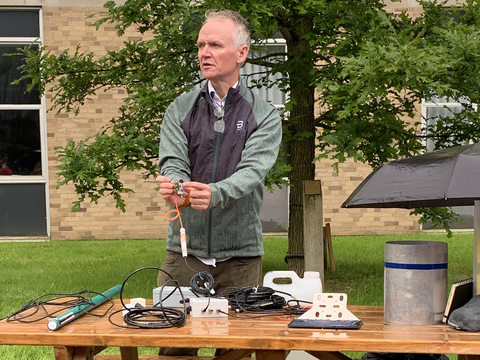
Dr. Bruce MacVicar providing an overview of the stormwater hydrology instrumentation to field day participants.
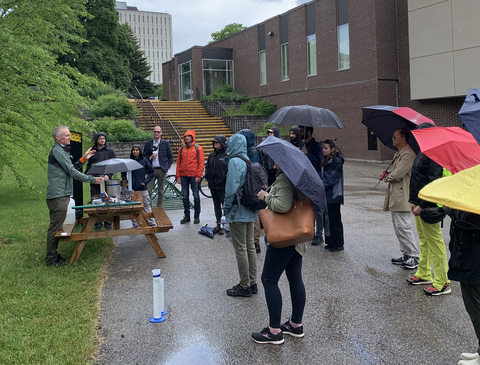
Field day participants braving a soggy morning to learn about stormwater hydrology from Dr. Bruce MacVicar.
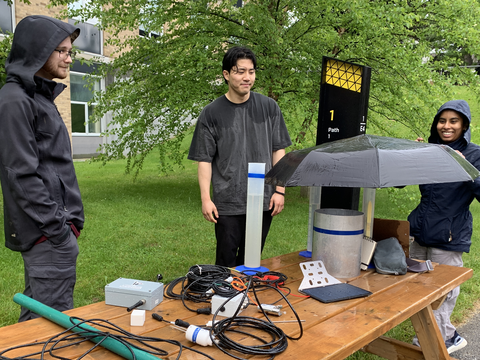
RISE students Jesse St. John-Parker, Jack Ha, and Thiruni Thirimanne setting up the stormwater hydrology instrumentation in the rain for demonstration to participants.
Towards the end of the morning, participants headed towards Brubacher House on north campus. During lunch, Dr. MacVicar went through the group’s preliminary data on weather, soil moisture, and tree hydrology from the campus living lab. Next, Dr. Derek Robinson introduced participants to his work using remotely piloted aircrafts to collect terrain and tree structure data for measuring carbon. With the weather making it impossible to fly that day, Dr. Robinson and his team (Chenxi Liu, Brandon Giura, Campbell Bowser) had set up the team’s remotely piloted aircraft indoors and provided an overview of the instrument and its components. They described how the data is being collected and what types of data are being collected, and the data processing needed to digitally construct tree structures and terrains that can then be used to calculate carbon estimates. Dr. Robinson also explained how the team is using additional tools to take tree measurements for comparison against the results from the remotely piloted aircraft, as well as survey equipment for check points (used in accuracy assessment) and ground control points (used to georeference the acquired data).
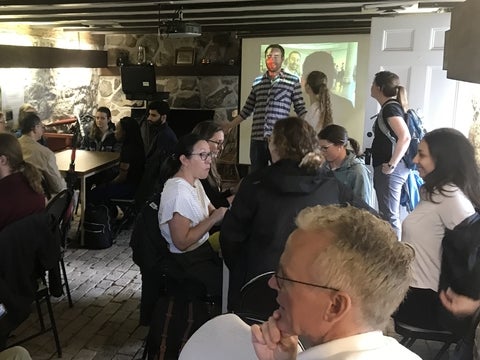
Dr. Derek Robinson presenting to participants during lunch at Brubacher House on his work on estimating terrestrial carbon using a remotely piloted aircraft.
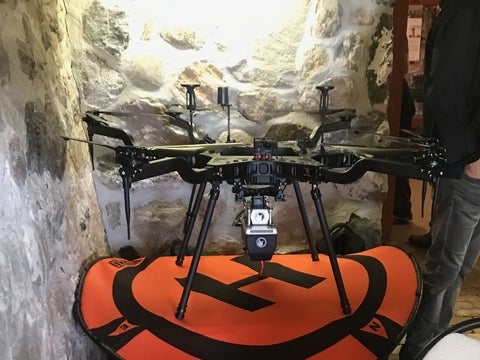
The remotely piloted aircraft used for terrestrial carbon data collection in the RISE project on display for participants at Brubacher House. The rainy weather meant that Dr. Derek Robinson and team could not fly that day.
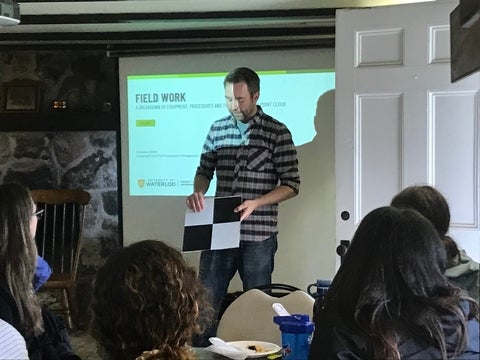
Dr. Derek Robinson explains how data collection for terrestrial carbon is done using the remotely piloted aircraft. Here, Dr. Robinson describes the markers used on the ground for referencing when doing a flight.
Before heading outdoors again for the afternoon, Dr. Maria Strack and Dr. Rebecca Rooney provided an overview of their aquatic carbon research and biodiversity research. Dr. Strack provided an overview of how she and her team (Akshara Withanage, Rayden Laliberte) are calculating greenhouse gas exchange and carbon storage in stormwater ponds. Her team has already been taking measurements to calculate greenhouse gas fluxes, such as methane, at stormwater ponds in the Kitchener-Waterloo area using floating gas chambers. Additionally, her team has been collecting sediment samples from stormwater ponds to look at the connection between sediment depth and carbon stocks. Dr. Rooney described how she and her team (Liahm Ruest) have been looking at stormwater pond ecology to understand how biodiversity can be enhanced to provide more habitat value in urban areas. They’ve determined that biodiversity in stormwater ponds depends largely on both the landscape context and pond characteristics. So far, through their sampling in the Kitchener-Waterloo area, they’ve determined that many frogs occur in urban stormwater ponds.
To cap off the day, participants headed outdoors to a stormwater pond on north campus for a last set of demonstrations. Participants were able to see the floating methane gas chamber in action and were able to witness in person the “bubbling” occurrence during measurement. There were also different biodiversity samples available for participants to examine, displaying the amazing diversity of creatures living in stormwater ponds. Finally, participants learned how our team measures water quality using a multiparamater sonde.
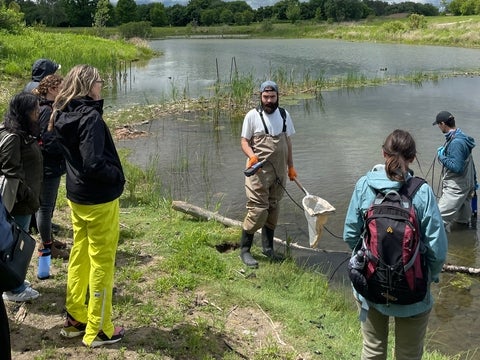
During a rare bit of sunshine that day, RISE team member Liahm Ruest (centre) provides a demonstration of biodiversity sampling at Columbia Lake on north campus.
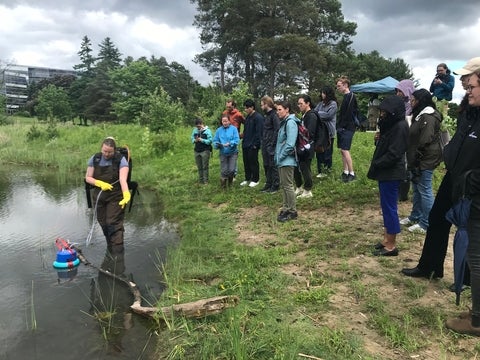
RISE team member Rayden Laliberte (left) demonstrating the floating gas chamber in Columbia Lake while field day participants look on.
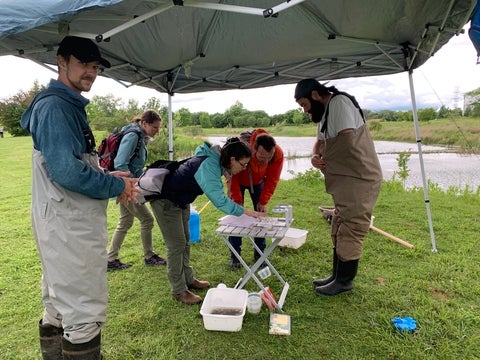
Dr. Rebecca Rooney (centre left) describes biodiversity samples to RISE Project Director Michael Drescher (centre right) while team member Liahm Ruest (right) looks on.
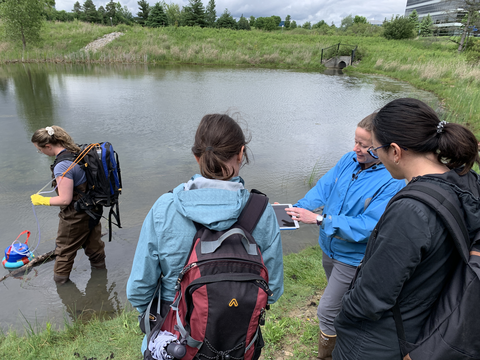
Dr. Maria Strack (second right) shows participants the live measurements from the floating gas chamber demonstration.
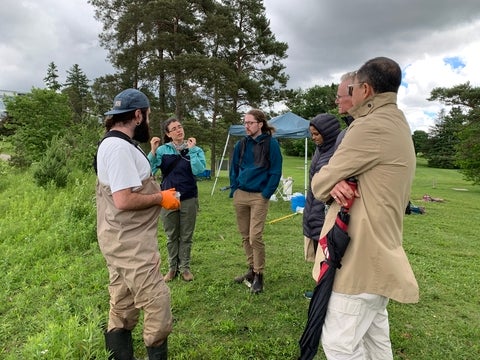
Dr. Rebecca Rooney (second left) with team member Liahm Ruest (left) speaking with field day participants about biodiversity in stormwater ponds.
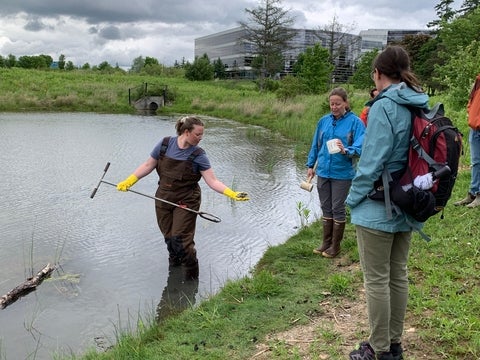
RISE team member Rayden Laliberte (left) shows a sediment sample taken from Columbia Lake to field day participants.
The RISE team is delighted that project partners joined them for the day! A big thank you to all the project partners who came out to learn about and experience the field work demonstrations.